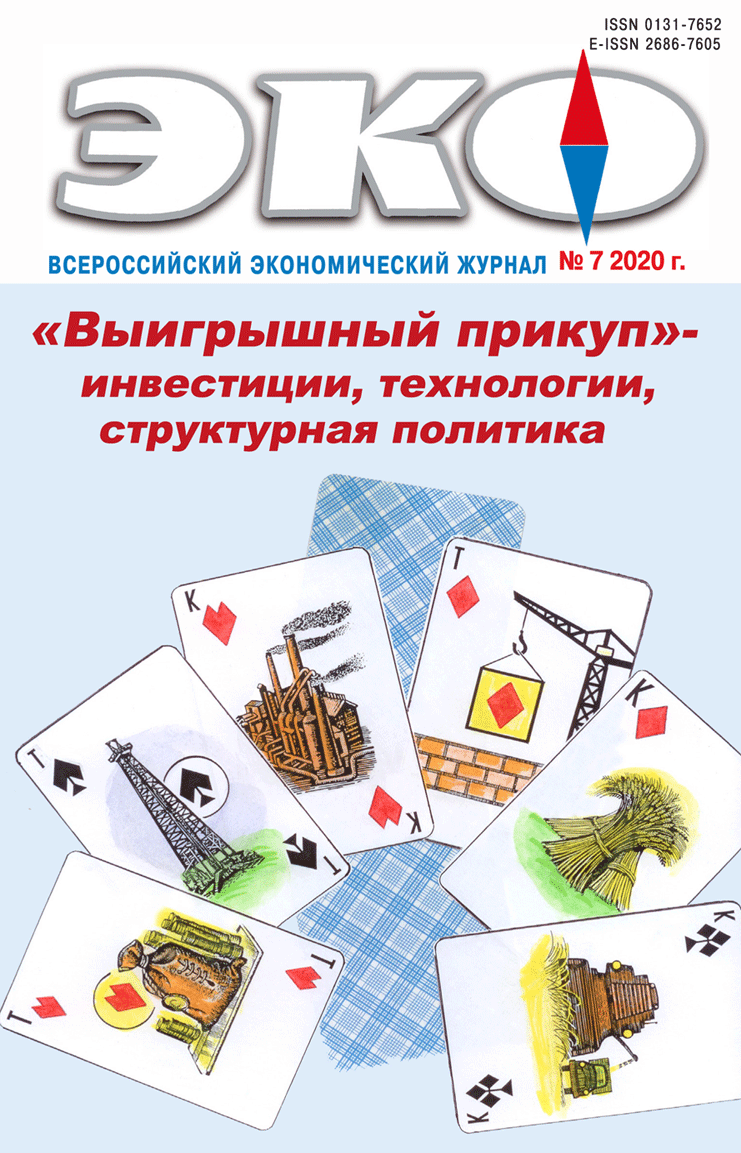ТРУДОВЫЕ ОТНОШЕНИЯ
Published 2020-07-02
Keywords
- informal employment,
- informal economy,
- informal sector employment,
- precarization of employment,
- labor market
- decent employment,
- entrepreneurship,
- shadow economy ...More
How to Cite
1.
Nekipelova Д. Approaches to Regulating Informal Employment: Theory and Practice. ECO [Internet]. 2020 Jul. 2 [cited 2024 Nov. 22];50(7):75-99. Available from: https://ecotrends.ru/index.php/eco/article/view/4069
Abstract
The issue of spreading informal employment is relevant for many countries, regardless of their level of socio-economic development and has pronounced geographical and national specific features. Most countries try to optimize this phenomenon and maximize legalization of labor relations. The author of the paper analyzes various approaches to regulate informal employment, including those existing within the framework of dominant schools of thoughts, as well as implemented in practice by separate countries. Through analysis of existing theoretical and applied approaches, the author sets the goal of finding relevant solutions aimed at reducing informal employment and improving the quality of the general employment structure for the Russian labor market. Integration of successful foreign practices in Russian conditions can reduce the time and costs of implementing respective programs, as well as increase their effectiveness. The main conclusion of the study is that reduction of informal employment depends on implementation of integrated and systemic measures covering all areas of the institutional, economic, social and legal environment. In conclusion, proposals are presented which, according to the author, can form the basis of the state program of legalizing employment.References
- Барсукова С. Ю. Неформальная экономика: экономико-социологический анализ / С. Ю. Барсукова. М.: Изд. Дом ГУ-ВШЭ, 2004. 448 с.
- Бизюков П. В. Практики регулирования трудовых отношений в условиях неустойчивой занятости. М.: АНО «Центр социально-трудовых прав», 2013. 152 с.
- Вишневская Н. Т. Институт минимальной заработной платы в странах ОЭСР [Текст]: препринт WP3/2005/03 / Н. Т. Вишневская; Гос. ун-т – Высшая школа экономики. Сер. Проблемы рынка труда. М.: Изд. Дом ГУ ВШЭ, 2005. 47с.
- Золин И. Е. Об особенностях и содержании государственного регулирования рынка труда развитых стран на современном этапе // Национальные приоритеты: экономика и безопасность. 2016. № 1. С. 131–143.
- Маслова Е. В. К вопросу о системности регулирования неформальной занятости Вестник ВГУ. Сер. Экономика и управление. 2018. № 2. С. 104–110.
- Стратегия-2020: Новая модель роста – новая социальная политика. Итоговый доклад о результатах экспертной работы по актуальным проблемам социально-экономической стратегии России на период до 2020 года / Под ред. В. А. Мау, Я. И. Кузьминова. Т. 1. М., 2013.
- Сафонов А. Л., Некипелова Д. В. Неформальная занятость: влияние экономического кризиса на формы проявления и экономическую динамику Международная научно-практическая конференция «История и научное прогнозирование развития трудового права и права социального обеспечения» (Третьи Гусовские чтения): материалы конференции / Под общ. ред. Н. Л. Лютова Ф. О. Сулеймановой; сост. Н. Л. Лютов, Ф. О. Сулейманова. М.: РГ-Пресс, 2018. 424 с.
- Щербакова Е. М. Прогноз городского и сельского населения мира, 2018 // Демоскоп Weekly. 2018. № 773–774. URL: http://demoscope.ru/weekly/2018/0773/barom01.php (дата обращения: 15.12.2019).
- Boeke J. N. Economics and Economic Policy of Dual Societies. N.Y., 1953.
- Castells, M. and Portes, A. World Underneath: The Origins, Dynamics, and Effects of the Informal Economy//In A. Portes, M. Castells & Lauren A. Benton, eds. The Informal Economy: Studies in Advanced and Less Advanced Developed Countries. Baltimore, MD, USA: John Hopkins University Press. 1989. Рp. 11–37.
- Chacaltana J. Peru, 2002–2012: growth, structural change and formalization, Cepal Rewiev № 119, 2016. Рp. 45–64.
- De Soto H. The Other Path: the Invisible Revolution in the Third World. Perennial Library, Washington DC, 1989.
- De Soto H. The Mystery Of Capital: Why Capitalism Triumphs In The West And Fails Everywhere Else, 2000.
- Fields G. S. Labour Market Modeling and the Urban Informal Sector: Theory and Evidence // The Informal Sector Revisited / D. Turnham, B. Salomé, A. Schwarz (eds.). Paris: Development Centre of the Organization for Economic Co-Operation and Development, 1990.
- Geertz C. The Bazaar Economy: Information and Search in Peasant Marketing// American Economic Review. 1978. Рp. 28–32. Опубликовано: American Economic Association. URL: http://www.jstor.org/stable/1816656 (дата обращения: 20.05.2019).
- Harris John R. and Michael P. Todaro, 1970, «Migration, Unemployment and Development: A Two-Sector Analysis», American Economic Review. 60, 126–42.
- Hart K. Informal Income Opportunities and Urban Employment in Ghana / K. Hart // The Journal of Modern African Studies.1973. Vol. 11. № 1. Рp. 61–89.
- Kucera D., Roncolato L. Informal employment: Two contested policy issues – International Labour Review. Vol. 147 (2008). № 4. Рp. 321–348.
- Lewis W. Arthur Economic Development with Unlimited Supplies of Labor // The Manchester School. 1954. 22 (2). Рp. 139–191.
- Maloney W. F. Informality Revisited.// World Development. 2004. № 32 (7).
- Thomas JJ. Surviving in the city: The Urban informal sector in Latin America. 1995.
- Williams C. Formal and informal employment in Europe: beyond dualistic representations //European Urban and Regional Studies 16 (2). 2009. Рp. 147–159.

